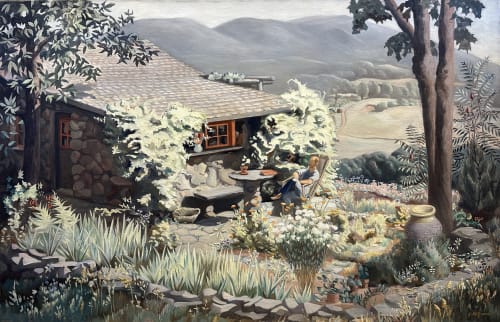Before the New York School there was Woodstock, New York, where many Hudson River painters of the nineteenth century lived and labored. Artists came to Woodstock in search of an untouched paradise, which is why Georgina Klitgaard (1893–1976) settled there in 1922 with her husband, artist and writer Kaj Klitgaard, to paint such exquisitely complex landscapes as The Ledge, 1936–37, which depicts her spouse relaxing outside their home, practically subsumed by verdant wilderness. Buttermilk Bay, Cape Cod, 1932, another tour de force of sophisticated perception, renders the outdoors with an epiphanic freshness ordinary eyes could never envision. Even when she ventured to Manhattan, as she did for Central Park South, ca. 1940, Klitgaard treated the city’s skyscrapers—modeled to appear as though they were constructed out of golden sand—as works of nature, with a certain resemblance to the dunelike structures in Desert, ca. 1938, perhaps the most metaphysically abstract work on view in “America Through Her Eyes,” an exhibition of the artist’s oils on canvas at Lincoln Glenn.
Johnny Walker’s Place, ca. 1929, and Newton’s Farm, ca. 1929, also suggest the triumph of the natural world, symbolized by the pictures’ grandly flourishing trees, which loom over so-called civilization, represented by tidy renderings of lifeless self-contained dwellings that feel pathetic and intrusive amid such splendor. In Arroyo Seco, New Mexico, ca. 1940s, a small orange house—a bleak rectangular box with one window—makes an anomalous appearance in a darkish landscape crowned by a luminous snowcapped peak. In Spring Ploughing, ca. 1929, thin saplings with pale blossoms dwarf the sturdy white and black horses harnessed to a plow. The man pushing the harvester seems only incidentally present. The red barn, all but hidden by the young trees, suggests the triviality of mankind and its sundry endeavors.
Meanwhile, the dramatic contrasts of cerulean, celadon, alabaster, evergreen, onyx, and ice blue in Catskill Mountains, ca.1933, convey Klitgaard’s marvelous sense of color: The eye moves from foreground to background, climbing the heights of the painting’s titular range. Her extraordinary attention to detail is particularly evident in Flower Mountains, ca. 1933, which features an exquisitely rendered efflorescence of delicate pink blooms on multiple summits—a springlike tableau as powerful as it is tender. And in Apples and Pears Still Life, ca. 1930, a large, bow-like leaf contains the namesake comestibles—a small radiant cornucopia reminding us of our dependence on the fruit of life.
In Carolyn Merchant’s The Death of Nature: Woman, Ecology, and the Scientific Revolution (1980), the author writes that “we must reexamine the formation of a world view and a science that, by reconceptualizing reality as a machine rather than a living organism, sanctioned the domination of both nature and women.” While Klitgaard’s landscapes record humanity’s presence in the world, we are made to appear as merely a blip within the long span of the earth’s existence (ironic, of course, given the irreparable damage man has caused to this planet). Klitgaard’s paintings have a deceptive air of innocence, but they are smart and sophisticated objects—uniquely relevant to the contemporary crisis of nature and art, lost in a labyrinth of possibilities.

